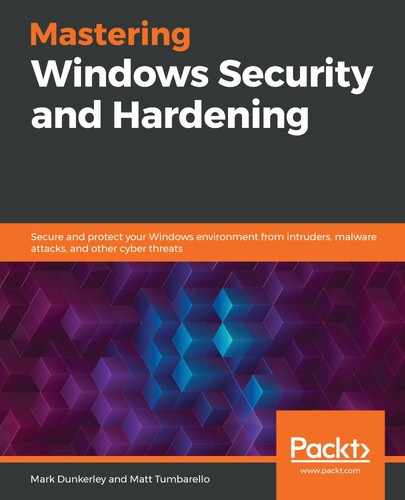Book Description
Enhance Windows security and protect your systems and servers from various cyber attacks
Key Features
- Protect your device using a zero-trust approach and advanced security techniques
- Implement efficient security measures using Microsoft Intune, Configuration Manager, and Azure solutions
- Understand how to create cyber-threat defense solutions effectively
Book Description
Are you looking for effective ways to protect Windows-based systems from being compromised by unauthorized users?
Mastering Windows Security and Hardening is a detailed guide that helps you gain expertise when implementing efficient security measures and creating robust defense solutions.
We will begin with an introduction to Windows security fundamentals, baselining, and the importance of building a baseline for an organization. As you advance, you will learn how to effectively secure and harden your Windows-based system, protect identities, and even manage access. In the concluding chapters, the book will take you through testing, monitoring, and security operations. In addition to this, you'll be equipped with the tools you need to ensure compliance and continuous monitoring through security operations.
By the end of this book, you'll have developed a full understanding of the processes and tools involved in securing and hardening your Windows environment.
What you will learn
- Understand baselining and learn the best practices for building a baseline
- Get to grips with identity management and access management on Windows-based systems
- Delve into the device administration and remote management of Windows-based systems
- Explore security tips to harden your Windows server and keep clients secure
- Audit, assess, and test to ensure controls are successfully applied and enforced
- Monitor and report activities to stay on top of vulnerabilities
Who this book is for
This book is for system administrators, cybersecurity and technology professionals, solutions architects, or anyone interested in learning how to secure their Windows-based systems. A basic understanding of Windows security concepts, Intune, Configuration Manager, Windows PowerShell, and Microsoft Azure will help you get the best out of this book.
Table of Contents
- Mastering Windows Security and Hardening
- Why subscribe?
- Contributors
- About the authors
- About the reviewer
- Packt is searching for authors like you
- Preface
- Section 1: Getting Started
- Chapter 1: Fundamentals of Windows Security
- Chapter 2: Building a Baseline
- Chapter 3: Server Infrastructure Management
- Chapter 4: End User Device Management
- Section 2: Applying Security and Hardening
- Chapter 5: Hardware and Virtualization
- Technical requirements
- Physical servers and virtualization
- Introduction to hardware certification
- BIOS and UEFI, TPM 2.0, and Secure Boot
- Advanced protection with VBS
- Hardware security recommendations and best practices
- Summary
- Chapter 6: Network Fundamentals for Hardening Windows
- Chapter 7: Identity and Access Management
- Technical requirements
- Identity and access management overview
- Implementing account and access management
- Understanding authentication, MFA, and going passwordless
- Using Conditional Access and Identity Protection
- Summary
- Chapter 8: Administration and Remote Management
- Chapter 9: Keeping Your Windows Client Secure
- Technical requirements
- Securing your Windows clients
- Introducing Windows Update for Business
- Advanced Windows hardening configurations
- Enabling Windows Hello for Business
- Managing BitLocker encryption
- Configuring Windows Defender AV
- Enabling Microsoft Defender SmartScreen
- Preventing name resolution poisoning
- Disabling the Web Proxy Autodiscovery Protocol (WPAD)
- Configuring Office security baselines
- Hardening Google Chrome
- Preventing user access to the registry
- Windows Defender Application Control
- Windows 10 privacy
- Summary
- Chapter 10: Keeping Your Windows Server Secure
- Section 3: Protecting, Detecting, and Responding for Windows Environments
- Chapter 11: Security Monitoring and Reporting
- Technical requirements
- Monitoring with MDATP
- Deploying Log Analytics
- Monitoring with Azure Monitor and activity logs
- Configuring ASC
- Creating performance baselines
- Summary
- Chapter 12: Security Operations
- Chapter 13: Testing and Auditing
- Chapter 14: Top 10 Recommendations and the Future
- The 10 most important to-dos
- Implementing identity protection and privileged access
- Enact a Zero Trust access model
- Define a security framework
- Get current and stay current
- Make use of modern management tools
- Certify your physical hardware devices
- Administer network security
- Always encrypt your devices
- Enable endpoint protection
- Deploy security monitoring solutions
- Other important items
- The future of device security and management
- Security and the future
- Summary
- The 10 most important to-dos
- Other Books You May Enjoy
